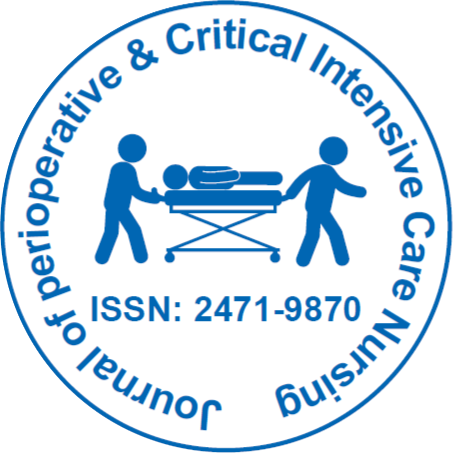
Journal of Perioperative & Critical Intensive Care Nursing
Open Access
ISSN: 2471-9870

ISSN: 2471-9870
Opinion Article - (2024)Volume 10, Issue 1
Patient monitoring is a foundation for modern healthcare, providing clinicians with real-time data to assess patient status, detect changes in condition, and intervene promptly when necessary. From basic vital sign monitoring to advanced telemetry and continuous surveillance systems, patient monitoring plays a critical role in ensuring patient safety and optimizing clinical outcomes. This article explores the significance of patient monitoring across various healthcare settings, highlighting its importance in promoting high-quality care and improving patient outcomes.
The importance of patient monitoring
Effective patient monitoring is essential for identifying and addressing changes in patient condition promptly. By continuously monitoring vital signs, physiological parameters, and other relevant indicators, healthcare providers can detect early signs of deterioration and initiate appropriate interventions to prevent adverse outcomes. Patient monitoring also allows for timely adjustments to treatment plans, medication dosages, and supportive measures, thereby optimizing patient care and minimizing the risk of complications.
Basic vital sign monitoring
Basic vital sign monitoring forms the foundation of patient assessment and monitoring in healthcare settings. Vital signs, including temperature, heart rate, blood pressure, respiratory rate, and oxygen saturation, provide valuable information about a patient's physiological status and overall health. By regularly measuring and recording these parameters, healthcare providers can track trends over time, identify abnormalities, and intervene as needed to maintain patient stability.
In addition to routine vital signs, other basic monitoring techniques may include assessments of consciousness, pain levels, and mobility. These assessments help healthcare providers gain a comprehensive understanding of the patient's condition and tailor interventions accordingly to meet their needs.
Continuous telemetry monitoring: For patients requiring more intensive monitoring, such as those in critical care units or recovering from major surgeries, continuous telemetry monitoring may be employed. Telemetry monitoring involves the use of specialized equipment to continuously monitor cardiac rhythms, oxygen saturation, and other physiological parameters in real time.
Telemetry monitoring enables healthcare providers to detect arrhythmias, ischemia, and other cardiac abnormalities promptly, allowing for timely intervention and treatment. It also provides valuable information about the patient's response to medications, interventions, and changes in condition, guiding clinical decision-making and optimizing patient care.
Advanced surveillance systems: In recent years, advances in technology have led to the development of advanced surveillance systems capable of monitoring multiple patients simultaneously in real time. These systems utilize wearable sensors, wireless connectivity, and data analytics algorithms to continuously monitor vital signs, movement, and activity levels, providing healthcare providers with a comprehensive view of patient status across various settings.
Advanced surveillance systems offer several advantages, including early detection of deterioration, reduced workload for healthcare providers, and improved efficiency in patient care delivery. By leveraging technology to automate routine monitoring tasks and streamline data collection and analysis, these systems enable healthcare providers to focus their attention on patients who require immediate intervention or assistance.
Remote patient monitoring: In addition to in-person monitoring, remote patient monitoring has emerged as a valuable tool for managing patients with chronic conditions or those recovering from acute illnesses or surgeries. RPM involves the use of wearable devices, mobile apps, and telecommunication technologies to monitor patients' vital signs, symptoms, and medication adherence from a distance.
Remote patient monitoring allows healthcare providers to monitor patients' progress, detect early signs of complications, and intervene as needed without requiring them to be physically present in a healthcare facility. This approach not only improves access to care for patients in remote or underserved areas but also enhances patient convenience and engagement in self-management.
Challenges and considerations: While patient monitoring offers numerous benefits, it also presents challenges and considerations that must be addressed to ensure its effectiveness and reliability. These may include issues related to device accuracy and reliability, data privacy and security, interoperability with existing healthcare systems, and clinician training and workflow integration.
Furthermore, the interpretation of monitoring data requires clinical judgment, critical thinking, and expertise to distinguish between normal variations and clinically significant changes. Healthcare providers must be vigilant in monitoring patients, recognizing subtle cues, and responding promptly to signs of deterioration to prevent adverse outcomes.
Patient monitoring plays a crucial role in modern healthcare, providing clinicians with valuable information to assess patient status, detect changes in condition, and intervene promptly when necessary. From basic vital sign monitoring to advanced telemetry and surveillance systems, patient monitoring encompasses a wide range of techniques and technologies designed to optimize patient care and improve clinical outcomes. By embracing innovative approaches to monitoring and leveraging technology to enhance data collection and analysis, healthcare providers can ensure the safety, well-being, and comfort of patients across various healthcare settings. As healthcare continues to evolve, patient monitoring will remain a fundamental component of high-quality care delivery, driving improvements in patient outcomes and advancing the practice of medicine.
Citation: Petkg K (2024) Elevating Healthcare and the Impact of Patient Monitoring on Clinical Outcomes. J Perioper Crit Intensive Care Nurs. 10:241.
Received: 13-Feb-2024, Manuscript No. JPCIC-24-30521; Editor assigned: 15-Feb-2024, Pre QC No. JPCIC-24-30521 (PQ); Reviewed: 01-Mar-2024, QC No. JPCIC-24-30521; Revised: 08-Mar-2024, Manuscript No. JPCIC-24-30521 (R); Published: 15-Mar-2024 , DOI: 10.35248/2471-9870.24.10.241
Copyright: © 2024 Petkg K. This is an open-access article distributed under the terms of the Creative Commons Attribution License, which permits unrestricted use, distribution, and reproduction in any medium, provided the original author and source are credited.